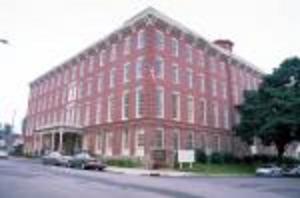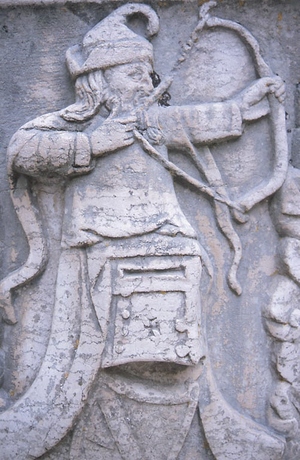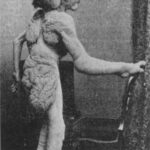Since the early years of my childhood were spent in St. Joseph, Jesse James loomed as a larger-than-life figure. After all, the small frame house where Jesse James was shot in the back was a local tourist attraction, and the story of the “dirty little coward that shot Mr. Howard and laid poor Jesse in his grave” remained popular. Eighty years after his death, Jesse was still regarded as something of a Robin Hood, a hero for the common man by most. When the Jesse James home was moved from the Belt Highway in St. Joe to the Patee House Museum, the house was returned to near its original location. On my first visit to the home, I entered through the back door in pursuit of some younger, boisterous cousins.
It was not yet re-opened to the public, and it seemed strangely like a house, not unlike many I’d visited, instead of a historical place. I retrieved my cousins and departed with apologies to the museum employee at work. The wall of the parlor, where the bullet passed through Jesse James’ head as he straightened a picture, had been gouged into a huge hole. Those seeking souvenirs had whittled it down over the many years until a glass was placed over it for protection. I recently saw that yet another attempt to prove that Jesse James survived the shooting in St. Joseph was under way. In Missouri, and throughout the country, numerous men claimed to have been the famous robber.
Even some historians seem to think Jesse James staged his own death in St. Joseph and escaped to live quietly for the rest of his years in another location. St. Joseph born and bred, I disagree. Mr. Howard, the alias used by James until his death, was well known in the community. After his death, he was recognized by many who were stunned to realize that the man they knew as Howard was actually one of the most notorious bank robbers of all time. Law enforcement officers gathered in St. Joseph to identify he body as James’. In my own family, stories have been handed down that make the identity of the dead man certain. Thomas Jefferson Lewis, my grandmother’s grandfather, was later sheriff of Buchanan County. On April 3, 1882, he was a law officer. He was one of many who were called to the simple frame house where the outlaw Jesse James lay dead. The story was one of several told to me by a great-uncle at a long-ago family reunion. Since Jesse James was known and because his face was featured on countless wanted posters, his identity was certain. In 1882, my great-grandfather Ben Hayward was living just blocks from the Howard home.
An English immigrant and railroader, Ben Hayward arrived home on the fatal April afternoon to find his quiet neighborhood in an uproar. One of the neighbors – a mild-mannered, unremarkable gentleman by all accounts – had been shot to death in cold blood with treachery. Even more sensational was the fact that the deceased was none other than the infamous Jesse James. Until he was shot by a comrade, Jesse James was living quietly without suspicion. It would have been foolish to blow his own cover by faking his death. The pictures of the late outlaw in his casket are stark reminders of the grim reality of death in those long-gone days. Viewed by thousands, there was no doubt that the dead man was truly Jesse James. Too many eye witnesses were able to identify the man as such. Over the years, many a would-be bandit told tall tales to their family and friends that they were indeed Jesse James.
One of the most famous lived for years at Stanton, operating the cavern there with his claims to be the outlaw. Jesse James, once merely a man on the wrong side of the law, became legend. With legend comes embellishment and untrue tales. The man became the myth and myths tend to be rather elusive. Born in St. Joseph – the city that bills itself as the place where the Pony Express began and Jesse James ended – I have no doubt that Jesse Woodson James’ remains lie quietly at Kearney, Mo., on the family farm. He lived a brief, memorable, violent life, and if he was a man of the times, he was still a criminal. By now, the real man has been all but lost in the myriad speculation and tall tales that spread like wildfire in the more than a century that has passed. Jesse James lived. He robbed. And he died in St. Joseph in 1882. That’s how the story goes.




